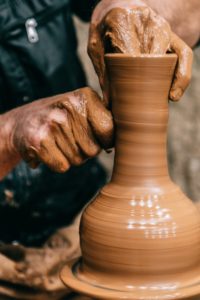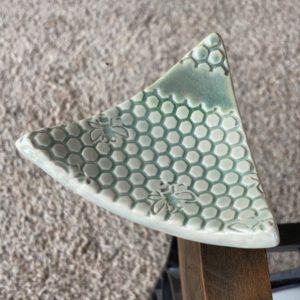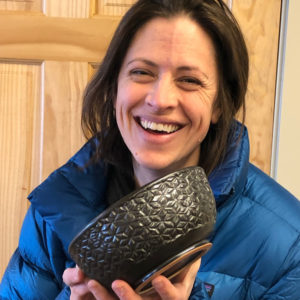Hands-On Art: Adding Beauty and Value Through Pottery

~24,000 BC is a time in history that’s tough to conceptualize. Primitive and almost otherworldly in comparison to present-day, it also holds the tools and beginning knowledge to shape what we know—and use—today.
There’s no better example than pottery, or ceramics: the mixing of mineral-rich clay into both functional forms and figures, then fired at high temperatures and decorated with a glass-like glaze.
In archaic societies, it also included animal fat and bone, and evolved into utilitarian pieces like bowls and containers in 9,000 BC. Today, the line is a bit more blurred. Handmade pottery both serves a practical purpose and stands as simply decorative and aesthetic, something that even expert potters don’t fully comprehend the meaning of.
“For some reason in life, beauty and art matters and adds value. It’s something I don’t really understand but it does. It’s mysterious,” Kate Lenz, owner of White Chapel Pottery in Appleton, says.
From hand molding to the introduction of the potter’s wheel, ceramics is one of the oldest forms of art that continues to evolve. There’s no denying its rich place in history or the stories it tells.
“It’s so earthy, just the smell of the wet clay is exciting,” Amanda Kabat, owner of Stoney Tree Studio in Larsen, says. “Anything can be. Anything you make is whatever you want it to be.”
The Pottery Process: Clay, Glaze + Tools
The terms “pottery” and “ceramics” are relatively interchangeable, but within the realm are items categorized in earthenware, porcelain and stoneware—distinguished by the temperature at which they’re fired.
“When a volcano erupts, it will erupt between 1,100-2,200 degrees,” Lenz says. “That’s how hot the magma is. Inside of my kiln we fire it hotter than that. It’s hotter than an erupting volcano! It’s fascinating.”
Earthenware: Fired between 1,000 to 1,150°. Most common uses for earthenware include roofing tiles, terracotta pots and dinnerware.
Porcelain: Fired between 1,200–1,450°. The result is an extremely hard, shiny material often white and translucent in appearance.
Stoneware: Fired at ~1,200°, resulting in a denser, stone-like quality. The finished product will be waterproof and unlike earthenware, does not need to be glazed.
“There are a lot of different clays: porcelain, white clay, black clay, speckled manganese, red clay, buff clay. I use a lot of buff clay because it’s forgiving! Porcelain is adored in the pottery world, it’s elevated and has a reputation of being more of a fine art,” Lenz explains. “They all have different vibes. The problem is, I think so many different vibes look really nice. So choosing one is very difficult.”

She suggests thinking of the difference as a lot of different minerals in the earth. And each mineral put together can produce a different result.
“It’s basically the difference in ingredients,” Lenz says. “Like the difference between a scone and a biscuit. They’re similar, but you kind of use some different things to make it just a little different.”
For Rick McKinney, owner of Fired Earth Pottery and MKM Pottery Tools in Appleton, what began as a career making and selling pottery became something more when he realized there was a need not being met in the industry.
“As a result of working in pottery every day, I came up with a variety of tools that were not available anywhere,” McKinney says. “These tools, such as the MKM Decorating Disk, a large selection of steel, coconut, and wood ribs, and throwing aids such as the MKM Throwing Tools, were admired by other potters, so I began the process of figuring out how to have them made commercially so that I could sell them alongside my pottery.”
Pottery tools can add textures and interest to the clay. And inspiration and influence are everywhere. Options are endless.
“Whenever I’m anywhere, I’m looking at textures,” Kabat admits. “I’ll buy doilies sometimes if they have cool textures. I’ll go to Goodwill and see something and think, ‘That would make a great bowl.’ Sometimes I think it’s all been done before. What can I possibly think of that no one else has? But inspiration is everywhere.”
Kabat has used a window screen and metal patio table to create texture in the past.
“Be sensitive to the emotional content of the things you make—and the things you own,” McKinney says. “Make what you like and then strive to make it better. This problem solving process over time eventually results in unique and personal creations that have great content and that uniquely represent you. In your art, as in your life, you are striving to achieve yourself.”
The final component in the actual crafting of pottery comes in the form of glaze, or “liquid glass,” a chemical reaction that produces beautiful results. Ranging in type and, of course, color, glaze can be smooth and gloss or satin, and also comes in speckled varietes. It can be painted on pottery pieces, sprayed on or dipped. The method depends ultimately on the look that’s wanting to be achieved, and also ease of use.
 “I paint on glaze… and I do hand drawing or decals,” Kabat says. “Sometimes I veer off but really when it comes down to it, I love green, I love learning about flowers and wild herbs and foraging,” Kabat says. “I dabble in that stuff a little bit in my pottery.”
“I paint on glaze… and I do hand drawing or decals,” Kabat says. “Sometimes I veer off but really when it comes down to it, I love green, I love learning about flowers and wild herbs and foraging,” Kabat says. “I dabble in that stuff a little bit in my pottery.”
“I really enjoy simplicity. A simpler kind of lovely,” Lenz adds. “Really appreciating the form and the beauty in very simplistic items and soft colors. Clean lines, that kind of thing.”
The Difference In Handmade Pottery
“For me, pottery is super involved and hands-on,” Kabat says. “If you’re buying handmade pottery items from someone… it’s handled the whole time. It’s lovingly created. Pottery is forever. It’s a rock, it’s glass. It’s time. It’s never going to rot away.”
The process, whether on a wheel or hand built, takes time. Preparation begins with slicing the clay to a particular weight and “wedging,” kneading dough to remove air bubbles.
“When someone wants a mug, I usually say three weeks,” Kabat explains. “It’s not because I’m there watching it that long but it takes time to make it, dry it, fire it… it’s letting the kiln warm up and cool down… it has to go through a process.
“What about ceramics is so great? Maybe it is the time… the unknown at the end,” Kabat says. “You wait to open that kiln after you put all of your effort into it: building it, babying it so it doesn’t crack, getting the glaze on just right. Then you wait for the second firing to see if all of your efforts paid off.”
“There is a tremendous satisfaction with being able to earn a living by selling things you make. This is a bit of a tough path requiring considerable persistence and commitment (especially from those you love, such as a life partner),” McKinney explains.

“The thing that an artist hates more than anything is pricing their stuff. It’s torture,” Lenz adds. “You’re literally saying, ‘How much am I worth, and will other people agree with me?’ That’s a question you have to ask with every item. Please be understanding!”
If pottery is something you’ve always wanted to try, our experts say the best way to do so is to simply jump in and “do”—either by taking a local class or using at-home methods like virtual courses.
“There are great people in the area who do classes. Find someone who can be patient with you,” Lenz suggests. “Or if you just want to do it at home, I mean, what can’t you learn on YouTube now?”
“Don’t be afraid of trying!” Kabat urges. “If you wait and don’t do something now, then what? It will be ten years down the road and you still haven’t done it. Do it now, follow the dream!”










Leave a Comment